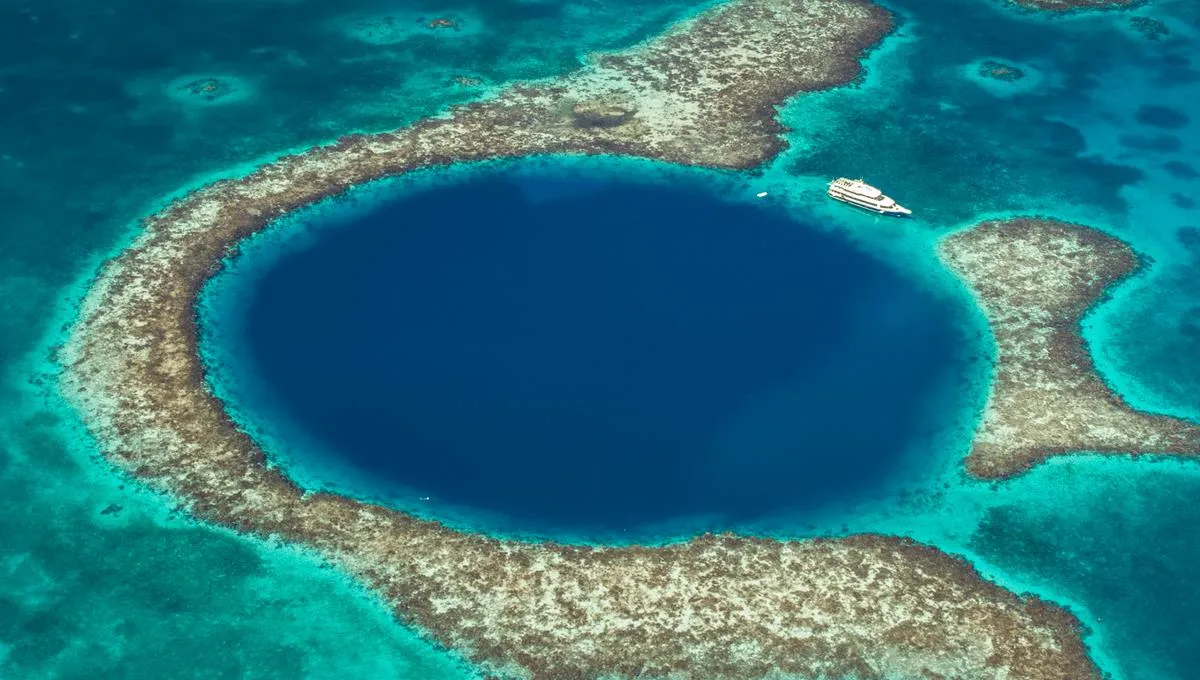
The Great Blue Hole is a spectacular marine sinkhole located in the Lighthouse Reef Atoll, approximately 80 kilometers (about 50 miles) off the coast of Belize in the Caribbean Sea. Known for its stunning deep blue color, this enormous circular opening plunges to a remarkable depth of 124 meters (407 feet). From above, it appears as a vast and mysterious dark blue hole amidst the atoll's shallow, turquoise waters, captivating the interest of divers and researchers alike.
The formation of the Great Blue Hole is a fascinating tale that dates back to multiple glaciation periods when sea levels were significantly lower than they are today. During these times, the area was above sea level, allowing for the development of an intricate limestone cave system. As the glaciation periods ended and sea levels rose, these caves became submerged. Eventually, the weight of the water caused the caves to collapse, resulting in the creation of the large circular marine sinkhole that we see today.
Over the past 20,000 years, the bottom of this submerged pit has been collecting sediment, with each layer acting as an archive of extreme weather events in the region. In the summer of 2022, a team of scientists led by the Goethe University Frankfurt embarked on an expedition to Belize. They successfully retrieved a 30-meter (98-foot) sediment core sample from the Great Blue Hole using a specialized drilling platform transported to the site. This sediment core provides invaluable insights into ancient climatic and weather conditions spanning thousands of years.
One significant focus of the research was identifying distinct sedimentary event layers known as tempestites. These layers are formed by aggressive waves and storm surges that transport coarse particles from the eastern reef edge into the marine sinkhole. The presence of these tempestites serves as a clear indicator of significant storm activity in the region. Through meticulous analysis, the research team identified a total of 574 storm events over the past 5,700 years, shedding light on the historical frequency of storms in this part of the Caribbean.
Dr. Dominik Schmitt, lead author of the study and a researcher in the Biosedimentology Research Group at Goethe University Frankfurt, noted that the unique environmental conditions of the Great Blue Hole, including oxygen-free bottom water and stratified water layers, allow fine marine sediments to settle undisturbed. The layers within the sediment core resemble tree rings, alternating in color between gray-green and light green based on organic content. The tempestites contrast with the fair-weather sediments in grain size, composition, and color, which ranges from beige to white.
The sediment cores indicated that the frequency of tropical storms and hurricanes in the southwestern Caribbean has progressively increased over the last six millennia. On average, this region experiences between four to 16 tropical storms and hurricanes each century. However, in the past 20 years alone, there have already been nine storms, suggesting that this century may witness a much higher frequency of storms than usual.
According to Professor Eberhard Gischler, head of the Biosedimentology Research Group, the findings suggest that approximately 45 tropical storms and hurricanes could affect this region within the current century. This prediction far exceeds the natural variability observed in past millennia. A significant contributing factor to this increase is the southward movement of the Intertropical Convergence Zone, a major weather belt that influences storm formation and trajectory. Additionally, rising sea temperatures are intensifying storms, creating ideal conditions for more frequent and powerful hurricanes.
The study authors emphasize that the sharp rise in storm activity is closely linked to human-driven climate change. The warming trends initiated during the Industrial Age have resulted in conditions that are conducive to an increase in the frequency and intensity of hurricanes, underscoring the urgent need to address climate change on a global scale.